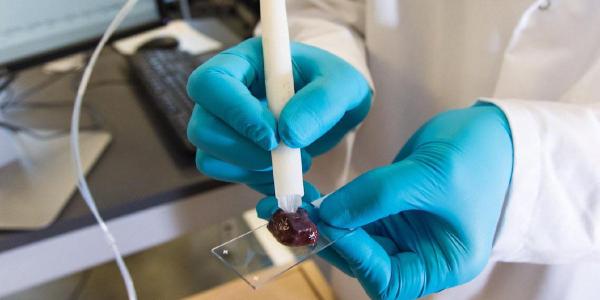Scientists have developed a “pen” that can help surgeons identify cancer cells within 10 seconds. The tool could one day be used during surgeries to quickly determine what tissue should be cut in order to remove tumors completely.
The device, called MasSpec Pen, isn’t perfect yet, however; it can distinguish between cancerous and healthy tissue with about 96 percent accuracy. But the team behind the device, described this week in the journal Science Translational Medicine, hopes that the pen will be tested in surgeries as early as next year.
When a patient undergoes surgery to get rid of a tumor, a surgeon tries to remove all cancerous tissue while preserving the healthy tissue. In the case of breast cancer, for instance, the task is particularly delicate, as the surgeon tries to remove the tumor while preserving the rest of the breast. Right now, surgeons can send tissue samples to a lab for analysis, which can take days. Tissue can also be frozen and analyzed during the operation, but that takes 15 to 20 minutes. (The more time-consuming method is more accurate than the so-called “frozen section,” according to the National Cancer Institute.)
In search for a quicker but still accurate tool, researchers in Texas developed a handheld “pen” that gets the job done in 10 seconds. It uses a tiny amount of water — 10 microliters — to extract molecules from a person’s tissue. The water-molecules combo is then sent through tubes to an instrument that can identify the molecular fingerprint of cancer, telling the surgeon whether the tissue is healthy or cancerous.
/cdn_vox-cdn_com/uploads/chorus_asset/file/9196373/zhang9HR.jpg)
The researchers tested the device on 253 human tissue samples of breast, lung, thyroid, and ovarian cancer, as well as healthy tissue. The pen was accurate 96 percent of the time, the study says. The researchers also tested the MasSpec Pen while operating on mice with tumors, finding that the device didn’t damage tissue or stress the animals.
Before the pen is adopted, it needs to be tested on more tissue samples, as well as during actual surgeries in clinical trials. It also needs to be approved by the US Food and Drug Administration. The instrument that actually analyzes the tissue takes up a lot of space for now, but the team is already testing a smaller one, according to STAT.
Still, the pen seems to be a big improvement on current methods, and the researchers hope to start testing it during surgeries in 2018.
Source by:- theverge
Share:


